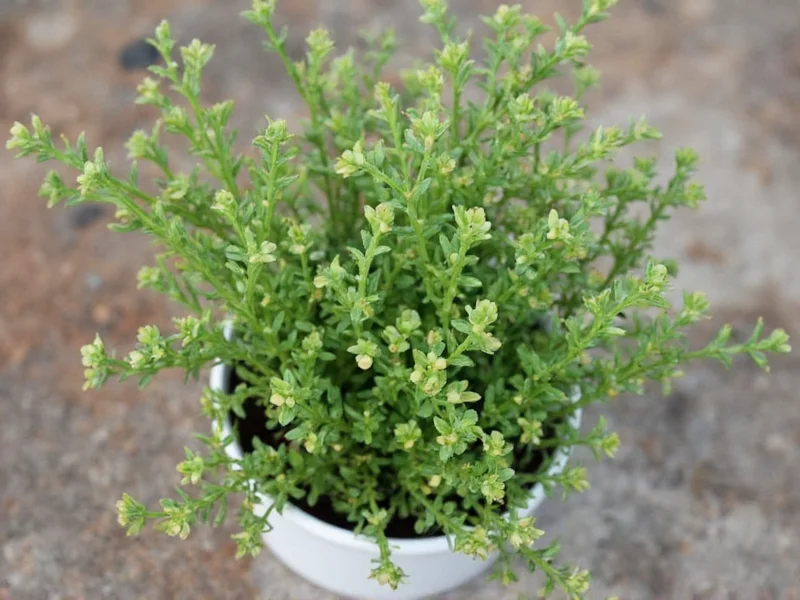Understanding the Japanese Thyme Misconception
Many gardeners and cooks encounter confusion when searching for “Japanese thyme.” Despite the name, this plant has no botanical connection to Japan. The term refers to Thymus praecox ‘Albiflorus’, a low-growing perennial native to Europe and Asia Minor. Landscape professionals often use it as drought-tolerant ground cover due to its hardiness and carpet-like growth pattern.
Botanically speaking, true thyme species (Thymus vulgaris and relatives) originate from Mediterranean regions. Japan has no native thyme varieties, which explains why this herb never became part of traditional Japanese culinary practices. The “Japanese” label likely emerged from Western landscaping terminology describing its suitability for Japanese-style rock gardens.
Thyme in Japanese Culinary Context
When exploring thyme japanese cooking applications, it's crucial to understand that authentic Japanese cuisine developed without thyme. Traditional Japanese herbology features completely different botanicals:
| Traditional Japanese Herb | Western Equivalent | Common Uses |
|---|---|---|
| Shiso (Perilla) | Basil/Mint hybrid | Sushi garnish, pickling, salads |
| Myŋgā (Welsh Onion) | Green onion | Ramen, miso soup, grilled dishes |
| Sansho Pepper | Szechuan pepper | Grilled fish, soups, spice blends |
| Mitsuba | Celery leaf | Salads, soups, garnishes |
These native herbs form the aromatic foundation of Japanese cooking, making thyme unnecessary in traditional preparations. Chefs seeking thyme japanese fusion recipe ideas should consider how thyme's earthy, slightly minty notes might complement rather than replace these established flavors.
Growing What's Called Japanese Thyme
Thymus praecox ‘Albiflorus’ thrives in conditions similar to Japanese rock gardens, explaining its landscaping nickname. This hardy perennial offers several advantages for gardeners:
- Tolerates USDA zones 4-9 with minimal care
- Requires only 2-3 inches of height maintenance
- Produces delicate white flowers in spring
- Withstands foot traffic better than most ground covers
- Needs full sun and well-draining soil
When establishing japanese thyme ground cover, plant in early spring after frost danger passes. Space plants 6-12 inches apart to allow for spreading. This variety rarely needs fertilization and resists most pests, making it ideal for low-maintenance landscapes. Unlike culinary thyme, it has minimal fragrance when touched.
Modern Culinary Applications
Contemporary chefs experimenting with thyme in japanese fusion dishes find success using it sparingly with compatible ingredients. Consider these pairing principles:
- Balance intensity: Use half the thyme you'd normally apply since Japanese cuisine favors subtlety
- Complement umami: Pair with dashi, miso, or shiitake mushrooms rather than competing with them
- Timing matters: Add at the end of cooking to preserve delicate flavor notes
- Regional fusion: Works best with Kyushu-inspired dishes that already incorporate Western ingredients
For example, a japanese thyme marinade for chicken might combine 1 teaspoon chopped thyme with 2 tablespoons mirin, 1 tablespoon soy sauce, and 1 minced garlic clove. Let the chicken marinate for 30 minutes before grilling. The thyme adds complexity without overwhelming the dish's Japanese character.
Substitutes in Authentic Japanese Cooking
If you're searching for thyme substitute japanese recipes, consider these authentic alternatives:
- Shiso leaves: Provides similar herbal complexity with distinctive Japanese flavor
- Mitsuba stems: Offers mild celery-like notes that work in broths and sauces
- Yuzu zest: Delivers bright citrus notes that complement many dishes thyme might season
- Grated ginger: Adds warmth and depth to marinades and sauces
These substitutions maintain culinary authenticity while providing comparable aromatic complexity. Remember that traditional Japanese cooking emphasizes showcasing individual ingredients rather than blending flavors—a fundamental difference from Mediterranean cuisine where thyme plays a central role.
Conclusion: Respecting Culinary Traditions
The term japanese thyme plant represents a common horticultural misnomer rather than a botanical reality. Understanding this distinction helps gardeners select appropriate ground covers and enables cooks to make informed decisions about ingredient substitutions. When exploring cross-cultural cuisine, respecting the integrity of each tradition while thoughtfully incorporating new elements creates the most successful fusion dishes. Whether you're landscaping with Thymus praecox or experimenting with herb combinations in the kitchen, accurate knowledge forms the foundation for successful results.
Frequently Asked Questions
Is Japanese thyme actually from Japan?
No, Japanese thyme (Thymus praecox ‘Albiflorus’) is not native to Japan. It originates from Europe and Asia Minor. The name comes from its popularity in Japanese-style rock gardens as a ground cover, not from any botanical connection to Japan.
Can I use thyme in traditional Japanese recipes?
Thyme doesn't appear in authentic traditional Japanese recipes. Japanese cuisine developed using native herbs like shiso, myŋgā, and sansho pepper. For fusion cooking, use thyme sparingly—about half the amount you'd use in Western dishes—to avoid overwhelming the delicate balance of Japanese flavors.
What's the difference between Japanese thyme and regular thyme?
Japanese thyme (Thymus praecox) grows low to the ground (2-3 inches) and spreads widely as ground cover with minimal fragrance. Regular culinary thyme (Thymus vulgaris) grows taller (6-12 inches), has stronger aroma, and contains higher thymol content for cooking. Only T. vulgaris works well as a culinary herb.
What herb can replace thyme in Japanese cooking?
For authentic Japanese dishes, substitute thyme with shiso leaves (for herbal notes), mitsuba (for mild celery-like flavor), or grated ginger (for warmth). These native herbs maintain culinary authenticity while providing comparable aromatic complexity in traditional preparations.
Does Japanese thyme have culinary uses?
Thymus praecox (Japanese thyme) has minimal culinary value due to its low essential oil content. While technically edible, it lacks the robust flavor of Thymus vulgaris. Gardeners should use it strictly as ornamental ground cover, not as a cooking herb. For culinary purposes, always select T. vulgaris varieties labeled for cooking.











 浙公网安备
33010002000092号
浙公网安备
33010002000092号 浙B2-20120091-4
浙B2-20120091-4